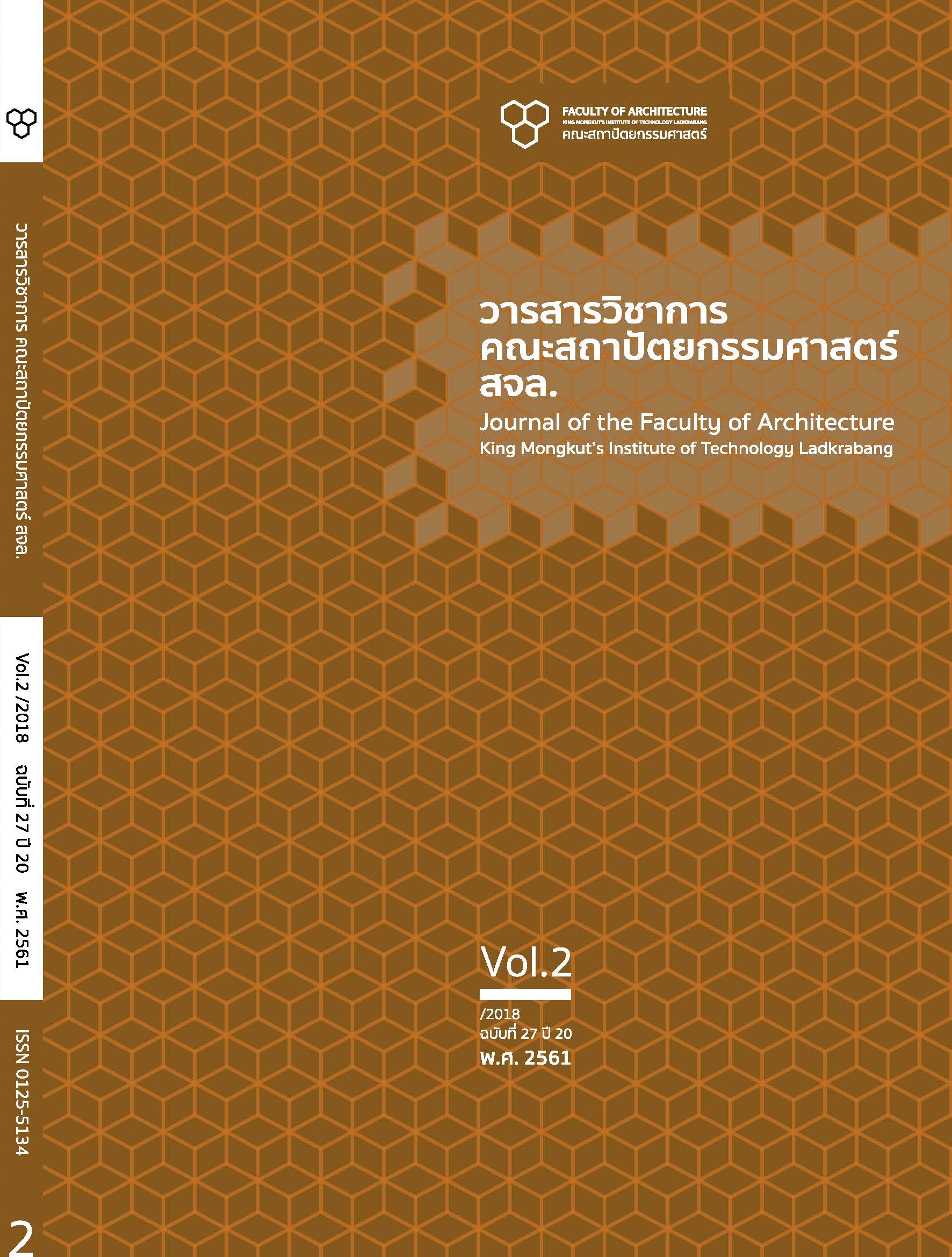การศึกษาอัตลักษณ์ทางสถาปัตยกรรมในความสัมพันธ์กับย่านมรดกชุมชนเมือง: กรณีศึกษา: พื้นที่ถนนเยาวราช The Study of Architectural Identity in Correlation with Urban Heritage Area: the Case of Yaowaraj Road
Main Article Content
Abstract
บทคัดย่อ
การคงอยู่ของสถาปัตยกรรมซึ่งมีคุณค่าทางประวัติศาสตร์ในย่านมรดกชุมชนเมืองนั้น เป็นสิ่งที่ส่งเสริมให้พื้นที่มีอัตลักษณ์อันชัดเจน ปัจจุบันนี้แนวคิดการอนุรักษ์เมืองเก่าไม่ได้หมายถึงเพียงการรักษาสถาปัตยกรรมแบบดั้งเดิมเอาไว้เพียงอย่างเดียว แต่ยังรวมถึงการพัฒนาโครงการอสังหาริมทรัพย์ใหม่ที่พัฒนาอยู่บนฐานของสถาปัตยกรรมที่มีคุณค่าทางประวัติศาสตร์เพื่อเพิ่มมูลค่าทางวัฒนธรรมและเศรษฐกิจอย่างไรก็ตาม การออกแบบงานสถาปัตยกรรมใหม่ในพื้นที่ศูนย์กลางเมืองเก่าจำต้องมีความเข้าใจอย่างลึกซึ้งถึงความสัมพันธ์ระหว่างงานสถาปัตยกรรมและเมือง ซึ่งบทความนี้ได้นำเสนอแนวทางการศึกษาอัตลักษณ์ทางสถาปัตยกรรมในย่านมรดกชุมชนเมือง โดยเลือกถนนเยาวราชเป็นกรณีศึกษา
ผู้วิจัยได้ใช้วิธีเก็บข้อมูลผ่านการทบทวนวรรณกรรมและการสำรวจภาคสนาม โดยวางกรอบแนวความคิดในการวิจัยเป็นการศึกษาความสัมพันธ์ระหว่างอัตลักษณ์ของชุมชนเมือง และอัตลักษณ์ทางสถาปัตยกรรม โดยในประเด็นแรกประกอบด้วยการศึกษาโครงสร้างสัณฐานเมืองและจินตภาพเมือง ประเด็นที่สองประกอบด้วยการศึกษาประเภททางสถาปัตยกรรม การใช้งานสถาปัตยกรรม รูปแบบสถาปัตยกรรม และองค์ประกอบเชิงสัญญะทางสถาปัตยกรรม จากการวิเคราะห์ข้อมูลพบว่าอัตลักษณ์ทางสถาปัตยกรรมของอาคารส่วนมากในพื้นที่ศึกษามีความสอดคล้องกับลักษณะสัณฐานของเมืองที่ประกอบขึ้นจากพื้นที่ช่วงถนนที่มีขนาดไม่ใหญ่นัก และโครงข่ายระหว่างถนนหลักและตรอกซอกซอยทำให้เกิดอาคารขนาดเล็กเรียนกันเป็นแถว ทำหน้าที่รองรับการค้าที่ชั้นล่างและอยู่อาศัยชั้นบน มีความแตกต่างด้วยทางรูปแบบสถาปัตยกรรมที่พัฒนาไปตามความเปลี่ยนแปลงของยุคสมัยและประเภทของธุรกิจ นอกจากนี้การใช้องค์ประกอบเชิงสัญญะในการสื่อสารความเป็นจีนยังทำให้พื้นที่มีเอกลักษณ์พิเศษ อาจกล่าวได้ว่าความสอดคล้องในรายละเอียดต่างๆ เหล่านี้ได้ปรากฏเป็นองค์ประกอบเฉพาะทางจินตภาพเมืองของถนนเยาวราชที่ผู้คนรับรู้ผลการศึกษานี้ถือเป็นแนวทางหนึ่งในการออกแบบสถาปัตยกรรมที่แสดงอัตลักษณ์สอดคล้องกับลักษณะมรดกชุมชนเมืองของย่านชุมชนจีนในกรุงเทพมหานคร
คำสำคัญ: อัตลักษณ์ทางสถาปัตยกรรม ย่านมรดกชุมชนเมือง ประเภททางสถาปัตยกรรม รูปแบบทางสถาปัตยกรรมและถนนเยาวราช
Abstract
The presence of historical architecture in an urban heritage area supports the district’s strong identity.Current approaches of urban conservation have moved away from the preservation of traditional architecture alone. Development of new real estate projects can be based on characteristics of historical architecture to attain added cultural and economic values. Nevertheless, designing new buildings in an old urban center requires a great understanding of relationship between architecture and the city. This paper investigates architectural identity in urban heritage area by choosing Yaowaraj Road in Bangkok as a case study.
The method of study comprises of literature review and field survey while the conceptual framework is formulated to study the relationship between urban and architectural characteristics. On the first issue, this includes the study of the district’s morphology and mental image. For the latter, architectural type, use, style, and sign are considered essential. From the analysis, it is found that there are correlations between buildings’architectural identities and morphological structure of Yaowaraj Road formed as pattern of intricate urban blocks and interlaced network of main road and alleys. Small buildings are found aligned in row supporting and intensifying commercial activities on the ground while having upper floors for private uses. Architectural styles vary greatly according to different historical periods and types of business. Last of all, symbolic features to communicate Chinese identity additionally contribute to the district’s uniqueness. It can be argued that these correlations collectively appear as specific elements of Yaowaraj’s mental image perceived by people. The study’s result is a guideline on designing buildings that express architectural identities correlated with the urban heritage characteristics of Bangkok’s Chinatown.
Keywords: Architectural Identity, Urban Heritage, Architectural Type, Architectural Style and Yaowaraj
Article Details
This work is licensed under a Creative Commons Attribution-NonCommercial-ShareAlike 4.0 International License.
Copyright Transfer Statement
The copyright of this article is transferred to Journal of The Faculty of Architecture King Mongkut's Institute of Technology Ladkrabang with effect if and when the article is accepted for publication. The copyright transfer covers the exclusive right to reproduce and distribute the article, including reprints, translations, photographic reproductions, electronic form (offline, online) or any other reproductions of similar nature.
The author warrants that this contribution is original and that he/she has full power to make this grant. The author signs for and accepts responsibility for releasing this material on behalf of any and all co-authors.
References
สำนักงานปลัดกระทรวงการท่องเที่ยวและกีฬา.
ประวิทย์ พันธุ์วิโรจน์. (2544). เสน่ห์เมืองจิ๋ว ทำเลมังกรทอง. กรุงเทพฯ: กรีน พริ้นท์ จำกัด.สำนักงานเขตสัมพันธ์วงศ์.
วิมลรัตน์ อิสระธรรมนูญ. (2558). เอกสารประกอบการสอนวิชาการอนุรักษ์สถาปัตยกรรมและสิ่งแวดล้อม. กรุงเทพฯ:
คณะสถาปัตยกรรมศาสตร์ จุฬาลงกรณ์มหาวิทยาลัย.
วรรณศิลป์ พีรพันธุ์. (2553). กฎบัตรและมาตรฐานระหว่างประเทศที่เกี่ยวข้องกับการอนุรักษ์เมือง. วารสารวิจัยและสาระคณะสถาปัตยกรรมและผังเมืองมหาวิทยาลัยธรรมศาสตร์. 7(1) 2010, 5-6.
สำนักผังเมือง กรุงเทพมหานคร. (2552). 225 ปี กรุงรัตนโกสินทร์. กรุงเทพฯ: สำนักผังเมือง.
Barthes, R. (1967). Element of Semiology. France: Paris Editions du Seuil.
Catanese, J. and Snyder, C. (1979). Introduction to Architecture. Michigan: McGraw-Hill.
China National Tourism Administrations. (2017). Tourism Statistics. China: Ministry of Culture and Tourism of the People’s Republic of China.
Feilden, B. (2003). Conservation of Historic Buildings. United Kingdom: Oxford.
Lynch, K. (1977). Image of the City. USA: The university press & Harvard university press.
Renner, R. (2018). Urban Being Anatomy & Identity of the City. German: Braun Publishing AG.
Ross, M. (1996). Planning and the Heritage : Policy and Procedures. New York: McGraw-Hill.
Roy, E. (2017). Siamese Melting Pot. Singapore: ISEAS.
Unesco. (2000). Criteria for New Design in heritage Contexts. Retrieved from: https://www.unesco.org/cultural/heritage/.


